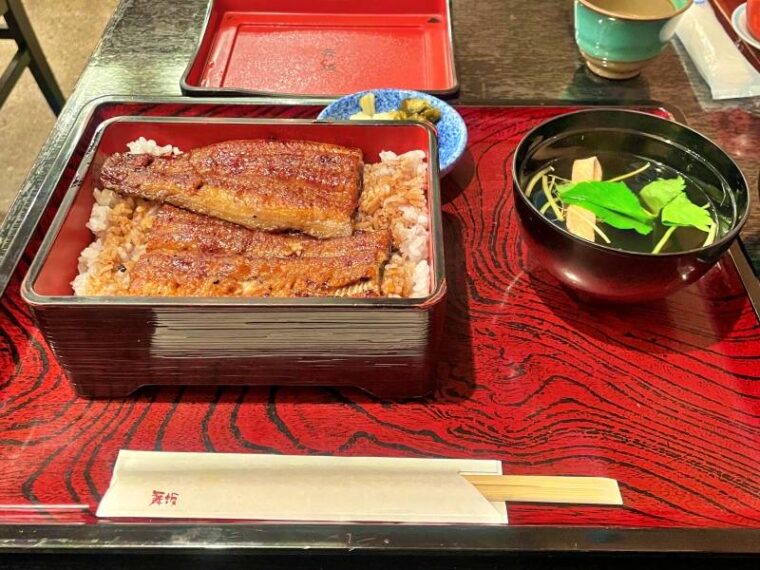Language:Japanese
“Maizaka” is a specialty restaurant of “eel” and “soft-shelled turtle” with more than 70 years of history in Kyoto, and you can enjoy an authentic “eel bowl” for about 2,000 yen during lunch time (11:00-15:00). They also have tempura set meals and sushi, but this time I had the “Unajyu (Matsu).”
*Unajyu means “grilled eel on rice”

The soup that comes with the “Unajyu” can be chosen from liver soup, red soup stock, or maru soup (soft-shelled turtle soup), and the “Unajyu (Matsu)” comes with a whole grilled eel on top.
Unajyu (Matsu)
Maisaka’s eel kabayaki is a “Kansai-style” dish characterized by crispy skin and fluffy meat, and the aroma of the charcoal grilled over binchotan(High-quality charcoal) charcoal brings out the indescribable flavor.
The secret sauce is of course excellent, and a sprinkling of bright green Japanese pepper, unique to Kyoto, enhances the flavor even more.

Plump flesh

Crispy and moist (exquisitely cooked)
Difference between Kanto style and Kansai style of grilled eel
Kanto-style cooking methods and procedures
- Opening the back (Edo was a samurai society; cutting the abdomen has the image of seppuku)
- Bake without adding anything
- Steaming (to easily soften the flesh)
- Use bamboo skewers
- Grill after cutting off the head
Kansai-style cooking methods and procedures
- Opening the belly (Kansai is a merchant culture: An image of opening the belly and talking)
- Don’t steam it (soften it using only baking techniques)
- Use gold skewers
- Cook with the head still attached and then drop it at the end
Eel liver soup
Maisaka’s “Maru soup (soft-shelled turtle soup)” is very delicious, so I was hesitant about whether to go with “eel liver soup,” but since the main ingredient is eel, I chose eel liver soup.
The “Eel liver soup” contains one eel liver and is garnished with a Itafu (sheet of wheat gluten) and Mitsuba (Japanese parsley). It is a very simple soup, but you can only get it at eel specialty restaurants.

Eel liver soup

Eel liver
Kyoto Maisaka Main Store

Maisaka, which has a history of over 70 years in Kyoto, is a specialty restaurant of eel and soft-shelled turtle. The main store is located right next to Kyoto Central Market, and is close to Umekoji Park, which is home to the aquarium and the Railway Museum.
The store has a take-out corner, a display window and menu sign next to the entrance, and a big blue tent as a landmark. Inside the store there are five four-seater tables and three two-seater tables, and there are private rooms and a large hall on the second and third floors.

The main dishes are eel and soft-shelled turtle, but since it is located near the central market, they also serve tempura and sushi, and in the summer they serve Hamo dishes, a Kyoto specialty.
Access
When is eel in season?
This is a bit of a digression, but have you ever wondered when eel is in season? In Japan, we have the impression that eel is in season during the hot summer months, but is that really the case?
In fact, the season for wild eel and farmed eel is different.
Wild eels begin hibernation in December when the water temperature drops below 8℃, so they start storing up nutrients in preparation for hibernation from around October. Therefore, October to December is the period when they are most fatty and delicious.
Farmed eels do not vary depending on the season because farmers carefully manage the water temperature and feed them appropriately while checking their growth. This means that you can eat delicious eels all year round.
So, if you want to eat wild eel, the recommended time is between October and December. However, even if they are selling wild eels, they are kept alive in aquariums, so the taste can change greatly depending on the time of purchase, so the best way to find out is to ask the restaurant staff.
It is essential to eat freshly grilled eel at a restaurant.
Grilled eel requires the skill of a craftsman, who says it takes three years to fillet, eight years to skewer, and a lifetime to grill, so the real thing is a delicate dish that can only be eaten at eel specialty restaurants.
Even if you buy eel from a specialty store in a crockpot and take it home, the correct way to eat it is while it’s warm; if you reheat it, the kabayaki will taste like simmered eel and will not be tasty.
Also, the sauce oxidizes over time, so it becomes a different thing by the next day.
Therefore, I do not recommend “grilled eel” sold at supermarkets or online.
In conclusions
This time, we introduced the “Unajyu (Matsu)” from the Kyoto Maisaka main store, but for lunch they also have other dishes such as “Unadon” for just over 2,000 yen. They also have dishes such as “Chirashi-don (Sushi bowl)” for just over 1,000 yen, so you can enjoy a casual lunch.

